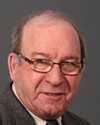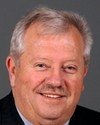Slide 3 shows a graph of the mineral production in Canada. Obviously Canada generates a very large amount of wealth from mineral and energy production. This slide shows a comparison of the mineral production in the provinces relative to the northern territories. You can immediately see that places like Ontario and Saskatchewan produce a fair amount of wealth; some $10 billion was produced last year in those two provinces. When you look at the Yukon, the Northwest Territories, and Nunavut on the right-hand part of the slide, you can see that the production is actually quite a bit lower.
The Northwest Territories stand out at about $2 billion per year. That's almost entirely generated by the diamond industry, which is about $2.1 billion per year, so from a geological perspective, one of the questions that we've certainly asked is why there is such limited production of mineral and energy resource in the north. If I showed you an equivalent graph for energy resource production, you'd see the same thing. It would be dominated by Alberta, of course, but in fact there's very little produced in the north in a proportionate sense.
From a geological perspective, which is our domain, this doesn't make an awful lot of sense. We know there's a very large potential for mineral and energy resource in the north, and yet the production isn't there. What started us thinking about this energy and minerals geomapping program was that we asked what the deficiencies were in trying to promote those economic development opportunities through energy and minerals in the north, because if you can have a couple of diamond mines adding $2 billion a year to an economy in one of the territories, that's quite a significant change in economic circumstances for those people.
Our feeling was there weren't a lot of economic opportunities of the same magnitude available to northerners. From our perspective, some of this is related to the lack of geological knowledge in the area. I'll talk about that in a bit more detail in a second.
Slide 4 shows our estimate of geological understanding in the north represented on a map. Our question was not so much what the available information was but more whether the available information was suitable for industry in terms of making the large-scale investments they have to in exploration.
We coloured the graph two different ways. Green indicates what we thought was an area where there probably was enough information for industry to go in and invest in exploring and developing mineral resources. Pink means we thought that the information was outdated and, for the most part, inadequate for that decision-making process that companies have to face.
You can see that a fairly large area is pink. It represents probably something in the order of 2,000,000 square kilometres of the north, or probably about 60% of the land mass, where we didn't think the geological information was quite up to standard.
I think this is one of the reasons that mineral production in the north is limited; it is simply because the understanding about where to invest is quite limited.
Another one, of course, is transportation infrastructure. If you find a diamond deposit, you can extract a fair amount of wealth in a small volume and a small weight, and transportation becomes a much easier problem to solve because you can fly things in and out. On the other hand, base metals such as lead and zinc have a huge volume and a huge weight, and without an acceptable transportation infrastructure they're effectively stranded resources that won't be developed. Companies are very aware of this, of course. They make decisions based on profit, so they focus on areas where they can extract the value in a way that they can economically justify.
Another aspect in the thinking of all the industry people is, of course, the regulatory situation. They have to be sure of that. They also have to be sure of things like an available workforce in order to provide people to work in their areas.
There are myriad factors, but we certainly felt that one of the basic ones was the understanding of the potential, because if you don't understand the potential for mineral or energy resources in the north, you're unlikely to take on the economic calculations for other factors, such as the regulatory system or the workforce system or the transportation system. That was the basic rationale for the program.
Slide 5 is a bit complicated, but it shows some of our reasons for trying to do this thing. We've found from past economic studies that when we invest a dollar's worth of public money in generating geoscience information, typically industry follows up and spends about five dollars pursuing whatever opportunities are created by that knowledge. Some people misunderstand this number, so I just wanted to be a little bit clear.
Industry never makes a profit until they actually find the resources and start to develop them; by providing this information about geoscience, we basically convince industry to spend more of their hard-earned money, or some of the capital they've raised on the markets, to explore, because they believe it gives them a chance to do a better job at discovering resources.
The analogy that's often used is that the public money that is invested by governments is trying to locate the haystacks; the industry still has to go into those haystacks and find the needle, which is the real prize. That's the goal here. We believe that this kind of work actually stimulates industry to do a fair amount of additional work, and that's the base for trying to create economic opportunities in the north.
Slide 6 talks about what the program was. We think that to provide reasonable geological information over all of the pink area would probably take about ten years and, in our estimate, about $200 million. We had the authority given to us in Budget 2008 and in subsequent announcements for $100 million over five years to begin the work. This is based on a plan of trying to complete the reconnaissance mapping over ten years, but we're going to try to produce a significant part of it and do at least 50% in the first five years.
Turning to slide 7, I want to emphasize that we're not doing this in isolation. We have an advisory structure that puts a lot of technical expertise into our decision making, so that we can be sure we're doing the right kind of science in the right ways. Much of that expertise is shared with the provinces and the territories, which have geological surveys of their own. The other thing we do is listen quite heavily to members of industry, because we have to understand how they make decisions about exploration in order to provide them the information they're going to find useful. We have quite an extensive advisory structure to give that information.
At the very bottom of this slide is something we've begun that is a bit new. We have taken the view that this program needs to leave benefits in the north for northerners. We've also assumed that we don't necessarily know how to do that ourselves in the Geological Survey of Canada or in Natural Resources Canada. So we formed an advisory group of northerners and meet with them at least twice a year to ask their advice about how we can ensure that whatever benefits are created by this program stay in the north long-term and that when the program is over there are still benefits accruing to northerners. I think that's been quite a successful enterprise.
Let's turn now to slide 8. Some of the results of advice we've received from our advisory group of northerners has enhanced our ability to hire local people from communities. We've engaged up to 20 people—it's actually 24, I think, this year—including prospectors, camp assistants, cooks. We've engaged the training societies and colleges in the north to try to get more people involved in this. Part of the thinking is that if we're successful in this, industry will follow and invest in exploration programs, and that people who learn about earth sciences and geoscience and exploration would be as useful to those people who follow us as they would be to us. We're trying to stimulate some thinking that the new economy that is emerging on the horizon requires some people with skills and training to support it.
The bottom part of the slide talks about SSO. I apologize for the acronym; that's a “shared service office” in NRCan. NRCan is starting to change the way it does procurement and contracting in the north to try to involve northerners more in that process. We're actively thinking not just about the lowest price anymore; we're thinking about trying to get northerners into this business, get them aware of how government issues contracts, and make sure that we can deal with northern businesses in a way that makes them fully competitive with the rest of the country. So NRCan is taking steps to be much more supportive of this relationship and not seek purely the best business deal.
Slide 9 shows some of the results we've had from the advice of our advisory group of northerners. We've always gone in and told people what we were planning to do and asked them what information they would like from us. Now we're trying to ask them some more questions about what additional information they might be interested in. Here we have a list of some of the things people have asked us about.
They're quite interested in what's happening with respect to permafrost degradation. They also want to know about resources, hiring local people.... One group asked us about training for cooks, because they anticipated more oil companies coming into their area and wanted to provide catering services to those companies. They wanted to know how to get training to do it. Our job is not really to do that, but we've certainly put them in touch with people who can provide that training.








